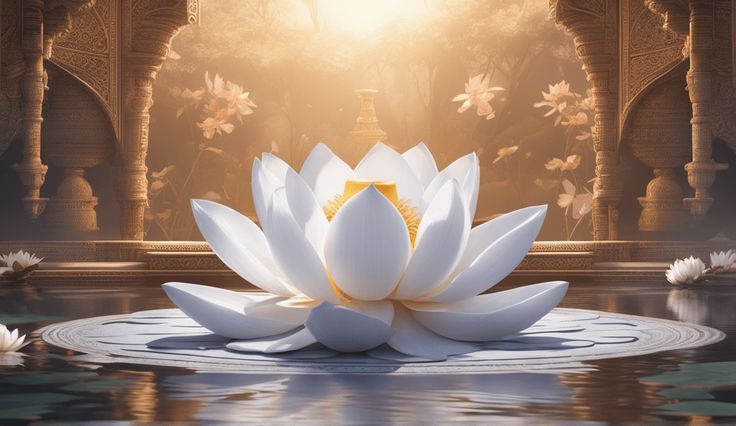The Significance of Lotus in Indian Art and Mythology

The lotus flower, revered for its beauty and purity, holds profound significance in Indian art, culture, and mythology. Across religions such as Hinduism, Buddhism, and Jainism, the lotus is an enduring symbol of spiritual enlightenment, transformation, and the connection between the material and spiritual worlds. Its presence in Indian mythology and art extends beyond its physical appearance, offering a rich tapestry of symbolism that continues to inspire and influence contemporary culture.
Symbolism of Purity and Enlightenment
One of the most significant aspects of the lotus in Indian culture is its association with purity and enlightenment. The lotus grows in muddy waters but rises above the surface, untouched by the impurities beneath. This is seen as a metaphor for the soul’s journey through the material world, striving for spiritual purity while remaining unaffected by worldly distractions. The image of the lotus blooming in pristine beauty has been used to represent the potential for inner purity, even in the most challenging circumstances.
In Hinduism, the lotus is linked to several deities, symbolizing divine beauty, power, and wisdom. For instance, the goddess Lakshmi, the goddess of wealth and prosperity, is often depicted sitting on a blooming lotus, which signifies her purity and divine grace. Similarly, the god Vishnu, a central figure in Hindu mythology, is often shown resting on a lotus that arises from the cosmic ocean, embodying the creation and preservation of the universe. The lotus, in this sense, acts as a vessel for divine presence and creation.
The Lotus in Buddhist and Jain Iconography
In Buddhism, the lotus carries a similarly important role. It is the symbol of spiritual awakening, representing the path to enlightenment. The Buddha is often depicted seated on a lotus, which signifies his rise above the suffering and ignorance of the world. The eight petals of the lotus are believed to symbolize the Eightfold Path, a central tenet in Buddhist teachings that guides individuals toward enlightenment.
Jainism also honors the lotus, though its symbolism differs slightly. In Jain iconography, the lotus is associated with purity and the attainment of spiritual goals. Jain Tirthankaras, revered spiritual teachers, are often shown seated or standing on lotuses, signifying their purity and their liberation from the cycle of birth and death.
The Lotus in Indian Art and Architecture
In addition to its religious and philosophical significance, the lotus is a prominent motif in Indian art and architecture. From ancient sculptures and paintings to temple designs, the lotus frequently appears as a symbol of divine beauty and grace. The intricate patterns of the lotus flower have been used to adorn temple walls, carvings, and textiles, elevating the visual language of Indian art.
The famous lotus-shaped architectural design of temples, particularly in South India, symbolizes the sanctity of the divine space within. The lotus petals are often depicted in sacred sculptures, signifying a connection between the physical world and the divine. The use of lotus imagery is especially prominent in Hindu temple architecture, where it reflects the aspiration to transcend the limitations of earthly existence and reach higher spiritual realms.
The Lotus in Cultural and Personal Identity
Beyond its religious and artistic significance, the lotus holds a place of great cultural importance in India. It is a symbol of beauty, grace, and hope, often associated with purity of mind and soul. The lotus flower is used in various forms of cultural expression, from dance performances to poetry, where it represents the journey of personal growth and spiritual realization.
In Indian literature, the lotus is frequently mentioned as a metaphor for the female form, symbolizing grace, beauty, and elegance. In poetry, it is often used to depict the blossoming of love or the opening of the heart to divine wisdom.
Conclusion
The lotus, with its multifaceted symbolism, continues to be a powerful emblem of spirituality, beauty, and divine grace in Indian culture. Its significance extends across various religions, from Hinduism and Buddhism to Jainism, where it embodies themes of purity, enlightenment, and transcendence. In Indian art, the lotus remains a vital symbol, representing the connection between the material and spiritual realms. As a motif, the lotus continues to inspire, offering a timeless reminder of the potential for growth and transformation, even in the most challenging circumstances. Whether depicted in temple art, religious scriptures, or cultural traditions, the lotus stands as an enduring symbol of India’s spiritual heritage.










